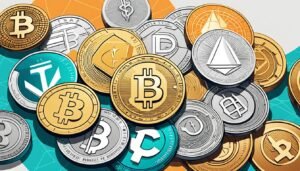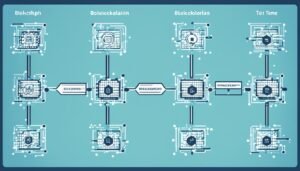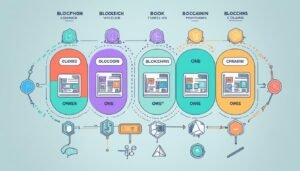The cryptocurrency market has seen a big comeback in the last year. It now has a market value of $2.66 trillion, close to its peak in 2021. This growth is thanks to Bitcoin ETFs and the Bitcoin halving event coming up in April 2024.
The Bitcoin halving happens every four years and slows down Bitcoin mining. This makes Bitcoin more valuable and prices go up. Experts think Bitcoin could hit a new high soon after the next halving. This could lead to a big increase in altcoin prices too.
The crypto world is changing fast, focusing on new altcoins with special features. These altcoins solve big problems and could bring big profits. They’re key to the future of blockchain and crypto markets.
Key Takeaways
- The upcoming Bitcoin halving event is expected to drive a surge in altcoin prices, with experts predicting possible returns of up to 30 times the initial investment in certain altcoins.
- Altcoins are diversifying beyond just payment coins, with various types emerging, including security tokens, stablecoins, utility tokens, and non-fungible tokens (NFTs).
- Factors to consider when investing in altcoins include market capitalization, historical performance, and the strength of the project’s team and technology.
- Leading altcoins like Ethereum, Binance Coin, Solana, and Ripple are shaping the future of the cryptocurrency market with their innovative solutions and growing ecosystems.
- The altcoin landscape is poised for continued growth and innovation, with a focus on addressing scalability, interoperability, and sustainability challenges in the blockchain space.
7 Decentralized Finance Trends Reshaping Altcoins’ Future
The world of decentralized finance (DeFi) is changing fast. It’s having a big impact on altcoins. Seven key trends are coming up that will change the future of altcoins.
The Intersection of AI and Crypto
AI and cryptocurrency are coming together. This has led to AI tokens, which are linked to an AI project. These tokens let users pay for services or access data and give holders a say in decisions.
The value of AI tokens jumped from $2.7 billion in April 2023 to over $39 billion. A big move came when Fetch.ai, SingularityNET, and Ocean Protocol merged. They created a new token called ASI to help advance decentralized AI.
DeFi solutions like Borroe Finance’s ROE token are challenging Ethereum’s top spot in DeFi. Web3 applications like InQubeta’s QUBE token offer new ways to fund AI startups. And GameFi projects like NuggetRush’s NUGX token mix gaming with real-world impact.
Top altcoins like Solana’s SOL are known for fast transactions and being decentralized. Quant’s QNT token is making DeFi investments better with its interoperability solutions. Polygon Matic is solving Ethereum’s scalability issues with layer-2 solutions.
Chainlink’s LINK token is a decentralized oracle network that connects blockchain smart contracts with outside data. This is making the altcoin market more powerful.
These trends in decentralized finance, AI tokens, and web3 applications are changing the future of altcoins. They’re driving more people to use cryptocurrency and opening up new possibilities for the industry.
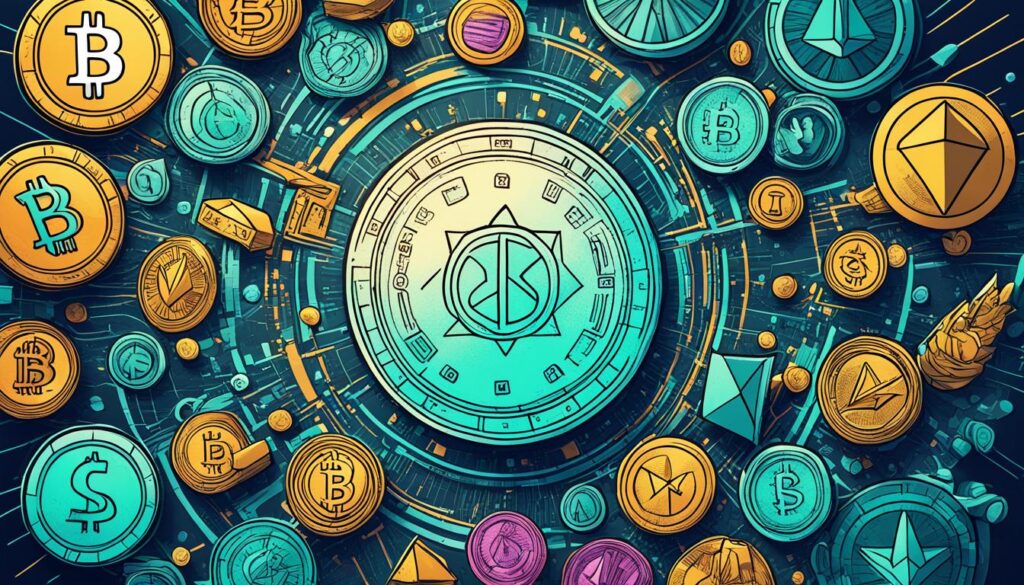
“The DeFi sector’s total value locked in protocols is projected to reach $60 billion, reflecting a significant expansion in this area of the altcoin market.”
The altcoin market is worth about $1 trillion, thanks to more institutional investment. The future looks bright for decentralized finance and AI-powered innovations to keep changing the altcoin landscape.
Breaking Down Altcoin Scalability Solutions: Innovations Explained
The cryptocurrency market is always changing, making scalable solutions key for altcoin adoption. Altcoins are leading the way in finding new ways to solve the scalability problem. They aim to make altcoins more useful for everyone.
Layer-2 scaling protocols, like Polygon, are a big step forward. They work on top of other blockchains to make transactions faster and cheaper. Kaspa uses the GHOSTDAG protocol for quick confirmations and high block rates. They focus on being fast, secure, and scalable.
Modular blockchains, such as Celestia and Dymension, are also changing the game. They’re designed to be flexible and secure, making altcoins more efficient and connected.
Parallelized Ethereum Virtual Machines (EVMs) are another big leap forward. Sei, Canto, Nomad, and NeonEVM break down complex tasks into simpler ones. This makes transactions faster and reduces delays on the Ethereum network.
The altcoin market is always moving, and scalable solutions are essential for its growth. The work on layer-2 protocols, modular blockchains, and parallelized EVMs shows the altcoin community’s dedication. They’re tackling the scalability issue head-on, shaping the future of blockchain.
| Altcoin Scalability Solution | Key Features | Examples |
|---|---|---|
| Layer-2 Scaling Protocols | Operate on top of existing blockchains to improve transaction speed and reduce fees | Polygon, Arbitrum, Optimism |
| Modular Blockchains | Leverage adaptable and customizable designs to enhance scalability, interoperability, and security | Celestia, Dymension |
| Parallelized Ethereum Virtual Machines (EVMs) | Break down smart contract execution into parallel tasks to improve transaction throughput and reduce latency | Sei, Canto, Nomad, NeonEVM |
The altcoin market is always changing, and scalable solutions are key for its growth. The work on layer-2 protocols, modular blockchains, and parallelized EVMs shows the altcoin community’s commitment. They’re working hard to solve the scalability problem and shape the future of blockchain.
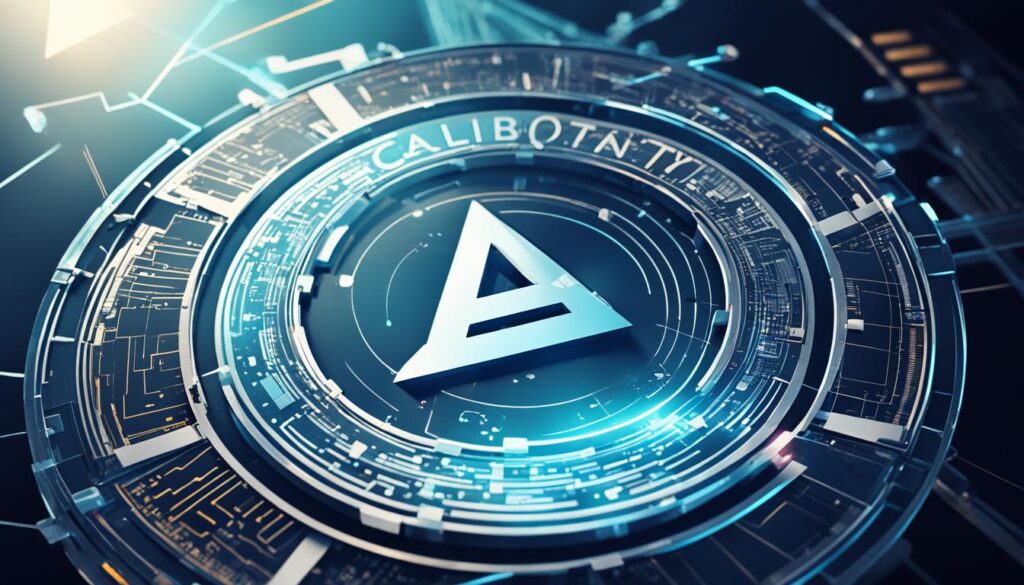
“The development of scalable solutions is critical for the long-term success of the altcoin market. Projects that can effectively address the scalability challenge will be well-positioned to drive broader adoption and growth in the decentralized finance space.”
Mastering Smart Contracts Evolution: Altcoins’ Integral Role
Smart contracts have changed the game in the altcoin world. They’ve changed how decentralized apps (dApps) are made and used. Ethereum leads with its smart contracts and decentralized computing. It’s a top smart contract platform, starting a new era of web3 development. Cardano and Solana are also growing their smart contract features. They let developers try out new altcoin use cases.
Altcoins are key in making smart contracts better and shaping their future. They help make fungible and non-fungible tokens (NFTs) and support decentralized finance (DeFi) apps. Smart contracts are now a big part of altcoin life. The rise of token economics shows how important they are for managing digital assets.
Altcoins help solve the scalability issues of old smart contract platforms. They use layer-2 solutions like sidechains and state channels to make smart contracts faster and more efficient. Also, altcoin regulations and compliance are key for smart contracts to be used safely and widely.
As smart contract platforms get better, altcoins will keep leading the way. They use their blockchain networks to bring more innovation, better user experiences, and new altcoin use cases. These changes will change how we use blockchain-powered apps.
Altcoins Beyond Finance: Exploring Non-Financial Adoption Trends
Altcoins started with financial uses like payments and investments. Now, they’re moving into new areas. They’re being used with new tech, showing up in more places.
Integrating Altcoins with IoT: A Step-by-Step Guide to Connectivity
Altcoins are now working with the Internet of Things (IoT). This lets devices talk to each other easily. It makes sharing data and value between devices simple.
Altcoins use blockchain’s secure nature for small transactions and device checks. They help automate processes in the web3 ecosystem.
Metaverse cryptocurrencies show how altcoins can create new virtual worlds and digital items. As more people use altcoins, these trends will shape the future of crypto.
Altcoins are finding new uses, like in supply chain management and DeFi. This shows the industry’s ability to meet new needs. It’s all part of the cryptocurrency trends.
The growth of altcoin use is changing industries. It’s making IoT connections and virtual experiences possible. Altcoins are going beyond just money matters.
Sustainable Altcoin Development: Trends for a Greener Crypto Future
The growth of the cryptocurrency market has made us think more about its environmental impact. Altcoin developers are now looking for new ways to be more eco-friendly.
They’re focusing on moving away from the energy-hungry proof-of-work (PoW) method. Instead, they’re looking at proof-of-stake (PoS). Cosmos and Solana have already made this switch, cutting down on energy use and carbon emissions. These altcoins have a big market value, showing they’re leading in sustainable development.
Altcoin developers are also finding ways to use renewable energy for their networks. This means using solar, wind, or hydroelectric power instead of fossil fuels. Some are even making their mining more eco-friendly by using less energy and water.
With more attention from governments on crypto’s energy use, making altcoins more eco-friendly is key. This will help the crypto industry grow and be accepted more widely. By going green, altcoin projects can lessen their environmental impact and lead in crypto’s sustainable development.
| Altcoin | Market Cap (as of April 24, 2024) | Consensus Mechanism | Sustainability Initiatives |
|---|---|---|---|
| Ethereum (ETH) | $395.03 billion | Proof-of-Work (transitioning to Proof-of-Stake) | Exploring renewable energy sources, improving energy efficiency |
| Cosmos (ATOM) | $3.41 billion | Proof-of-Stake | Utilizing renewable energy in mining operations |
| Solana (SOL) | $70.11 billion | Proof-of-Stake | Implementing sustainable mining practices, optimizing hardware efficiency |
The growth of crypto regulations and altcoin adoption will shape the future of crypto. Sustainable altcoins will be key in making crypto last and be accepted by more people.
Altcoin Security Innovations: Enhancing Privacy and Safety in Crypto Transactions
The world of cryptocurrency is always changing, making the security and privacy of digital transactions very important. Altcoins, which are different from Bitcoin, are leading the way in creating new solutions for these issues.
Projects like Monero and Zcash have brought in new ways to keep transactions private. They use advanced cryptography to hide who is sending and receiving money. This makes it harder for others to see who is involved in a transaction.
Also, the use of hardware wallets and multisignature technology has made altcoin transactions safer. These tools help protect digital money, letting users feel secure when they store and manage their cryptocurrencies.
As more rules are made for the crypto world, altcoins that focus on security and privacy are becoming more popular. People and big investors like these altcoins because they keep user information safe and fight against online threats.
“Altcoins are at the forefront of developing innovative solutions to address security and privacy concerns in the cryptocurrency industry.”
The future of altcoins depends on how well they improve their security and privacy. By focusing on these areas, altcoins can gain trust, get more users, and become a key part of the web3 world.
Exploring Cross-Chain Compatibility: Altcoins’ Potential and Challenges
Imagine if different blockchain networks could talk to each other. That’s what cross-chain compatibility is all about. Projects like Wormhole are working on this, making it easier to move assets and data between networks. This is key for altcoins to grow, as it makes using them easier and connects different blockchain apps.
But, making these networks work together is hard. It needs new ideas and teamwork in the crypto world. Altcoins are leading the way with blockchain innovations. For example, ZetaChain (ZETA) is a low-fee blockchain for developers, helping them build and support DeFi apps.
Also, projects like Cornucopias are linking altcoins with gaming and other areas. The altcoin market analysis shows more uses for cryptocurrencies beyond money. As crypto trends change, getting these networks to work together will help altcoins become more popular.
| Altcoin Project | Cross-Chain Compatibility Features |
|---|---|
| ZetaChain (ZETA) | L1 PoS blockchain with low fees, enabling developer activities and DeFi features |
| Cornucopias | Play-to-earn MMO with COPI tokens built on Ethereum, Cardano, and Bitcoin blockchains |
| 5ire Chain | Sustainable L1 project focused on reducing the environmental impact of blockchain networks |
| Artificial Superintelligence Alliance | Merger of Fetch.ai, Ocean Protocol, and Singular yNET for AI and web3 integration |
| Laika AI | Web3-powered platform accepted into Google Launchpad with a strategic partnership with Amazon’s AWS |
The future of crypto depends on making these networks work together. Success in cross-chain compatibility will boost altcoins, making the web3 ecosystem more connected and open.
Altcoin Market Insights: Trends, Analysis, and Future Forecast
The altcoin market has seen a lot of ups and downs and growth lately. By 2023, the total value of all cryptocurrencies hit $2.66 trillion. Bitcoin is still the top digital asset. But, altcoins like Ethereum, Solana, and Dogecoin are gaining ground, showing they could change the crypto world.
DeFi and new tech like AI and the metaverse are making altcoins more useful. Governments are also paying more attention, which brings both risks and chances for altcoins.
Ethereum is now worth $304.42 billion, making up over 17% of the crypto market. Solana’s value jumped by 26.00%, reaching $66.36 billion. Dogecoin also saw a 16.45% increase, now at $14.47 billion.
Other altcoins like Kaspa, Polygon, Stellar, and Cosmos are growing too. They offer new solutions for faster transactions and cheaper costs, making the altcoin world more exciting.
Investors should think about managing risks, not making decisions based on feelings, and spreading their investments. Using strategies like rupee-cost averaging and setting clear profit goals can help with altcoin investments.
The altcoin market’s future depends on how it deals with rules, brings in new users, and meets investor needs. With ongoing growth and innovation, altcoins could greatly change the financial world.
| Altcoin | Market Capitalization | 24-Hour Price Change |
|---|---|---|
| Ethereum | $304.42 billion | N/A |
| Solana | $66.36 billion | 26.00% increase |
| Dogecoin | $14.47 billion | 16.45% increase |
| Kaspa | $4.18 billion | N/A |
| Polygon | $4.10 billion | N/A |
| Stellar | $2.69 billion | N/A |
| Cosmos | $1.92 billion | N/A |
Many things affect the altcoin market, like demand, feelings, tech, rules, competition, and the economy. Investors should look at these factors and plan their investments well to succeed in the altcoin world.
“The future of the altcoin market will likely be shaped by the industry’s ability to navigate the regulatory landscape, provide innovative solutions that drive mainstream adoption, and address the evolving needs of both individual and institutional investors.”
A recent survey showed Solana leading with 34.9% of the votes, followed by Celestia and others. This shows the altcoin world is diverse and innovative.
As altcoins keep changing, investors should keep up, be careful, and spread their investments. By understanding the altcoin market, investors can find new ways to make money and help change the financial system.
Future Governance Models in Altcoin Innovations: A Strategic Overview
The world of cryptocurrency is always changing, making how altcoin networks are governed very important for their future. Many altcoin projects are looking into new ways to govern themselves. They’re using things like decentralized autonomous organizations (DAOs) to make their systems more open and fair.
DAOs let token holders make decisions, letting the community guide the altcoin’s future. This way, everyone feels like they have a say, making the altcoin stronger and more flexible.
But it’s not just about DAOs. Altcoins are also trying out other ways to govern themselves. They use altcoin governance, cryptocurrency trends, and web3 development to improve altcoin regulations and increase cryptocurrency adoption. These methods aim to balance quick development with the need for decentralization and community input. This helps altcoin projects stay relevant in a changing market and with new rules.
As the cryptocurrency world grows up, how well altcoins can govern themselves will be crucial for their success. By adopting new governance models, altcoin projects can lead the way in the future of cryptocurrency.
“The future of altcoin governance lies in empowering the community to shape the project’s direction, fostering a sense of shared ownership and responsibility.”
The altcoin governance scene is set for big changes with the rise of DAOs and new governance ideas. By keeping up with these changes, those interested in altcoins and investors can understand where the cryptocurrency market is headed.
Funding, Mergers, and Acquisitions in the Crypto Market
In the last quarter of 2023, investors put $1.9 billion into crypto funding for crypto companies. This includes big investments in projects like Wormhole, which raised $225 million for cross-chain connectivity. There’s also been a lot of mergers and acquisitions in crypto mining, with big companies buying smaller ones. These moves show the institutional interest and growth of the cryptocurrency market.
The Cryptocurrency market size was worth USD 1004.79 million in 2022. It’s expected to grow at a CAGR of 13.66% until 2028, reaching USD 2166.85 million. Companies like Bitfury Group Limited and Ripple Labs Inc. are big names in the Cryptocurrency market.
The altcoin market analysis shows the DeFi sector grew by 41.3% last year. This is less than the overall market and Ethereum’s 75.8% growth. But, top DeFi projects are doing well, with more users, positive cash flow, and looking good compared to other altcoins.
The cryptocurrency trends point to more mergers and acquisitions in the web3 ecosystem. This is especially true for DeFi, NFT projects, and memecoins. The market has too many similar projects, offering chances for consolidation.
| Metric | Value |
|---|---|
| Cryptocurrency Market Size (2022) | USD 1004.79 million |
| Cryptocurrency Market CAGR (2024-2032) | 13.66% |
| DeFi Sector Growth (Past Year) | 41.3% |
| Average Market Growth (Past Year) | 91% |
| Ethereum Growth (Past Year) | 75.8% |
The cryptocurrency market is changing fast. Trends in crypto funding, mergers and acquisitions, and altcoin market analysis show it’s getting more mature and attracting big investors. These changes are making the industry more innovative, from DeFi to memecoins.
Conclusion
The cryptocurrency markets are always changing. Altcoins are key in bringing new ideas and shaping the future. They’re tackling traditional finance’s limits and blockchain’s challenges.
As rules change and big investors come in, altcoins must adapt. Their success and widespread use depend on it. They’re leading the way in making finance better and safer.
Staying up-to-date with altcoin news helps investors and fans grab the next big chances. Altcoins like Binance Coin, Cardano, and Solana show their growth and innovation. They’re tackling issues like rules and market ups and downs.
The future of altcoins will be about offering real value, dealing with rules, and using new investment strategies. By keeping up and being active, investors and fans can be part of the big changes in finance and tech.
FAQ
What is the current state of the cryptocurrency market?
The cryptocurrency market has seen a big comeback, with its value reaching .66 trillion. This is close to its all-time high in 2021. The rise is thanks to Bitcoin ETFs and the Bitcoin halving event.
What is the impact of the intersection between AI and cryptocurrency?
AI and cryptocurrency have come together, creating AI tokens. These tokens are linked to AI projects. They let users pay for services or access data and give holders a say in the project.
What are the solutions for scalability issues in altcoins?
To fix scalability issues, layer-2 scaling protocols like Polygon are being developed. They work on top of the Ethereum network to make transactions faster and cheaper. Projects like Kaspa use the GHOSTDAG protocol for quick confirmations and high block rates, focusing on security and speed.
How are smart contracts impacting the altcoin ecosystem?
Smart contracts are key in the altcoin world. They make sure agreements are followed automatically on the blockchain. Ethereum leads in this area with its focus on decentralized apps and smart contracts. Other altcoins, like Cardano and Solana, also have smart contract features.
What are the non-financial adoption trends for altcoins?
Altcoins are being used in new ways, like with the Internet of Things (IoT). This lets devices talk to each other and share data and value. Also, metaverse-related cryptocurrencies are growing, showing how altcoins could change virtual experiences and digital asset ownership.
How are altcoins addressing environmental concerns?
Altcoins like Cosmos and Solana are looking into new ways to agree on transactions, like proof-of-stake. This can cut down on their environmental impact. Some altcoins are also focusing on using renewable energy and sustainable mining to lessen their ecological footprint.
What security and privacy innovations are being developed in the altcoin industry?
Altcoins like Monero and Zcash are working on privacy features. These include hiding transaction details and using anonymous addresses. Also, using hardware wallets and multisignature tech is making altcoin transactions safer.
What is the importance of cross-chain compatibility for the altcoin industry?
Cross-chain compatibility is key for altcoins. Projects like Wormhole make it easier to move assets and data between different blockchains. This makes altcoins more useful by breaking down barriers and connecting different blockchain apps.
How is the governance of altcoin networks evolving?
Altcoin networks are getting better at making decisions together. They’re using decentralized autonomous organizations (DAOs) to let token holders have a say. This aims to make the process of deciding on altcoin projects more open and fair.
What are the latest trends in funding, mergers, and acquisitions in the crypto market?
Investors are coming back to the crypto market, putting
FAQ
What is the current state of the cryptocurrency market?
The cryptocurrency market has seen a big comeback, with its value reaching $2.66 trillion. This is close to its all-time high in 2021. The rise is thanks to Bitcoin ETFs and the Bitcoin halving event.
What is the impact of the intersection between AI and cryptocurrency?
AI and cryptocurrency have come together, creating AI tokens. These tokens are linked to AI projects. They let users pay for services or access data and give holders a say in the project.
What are the solutions for scalability issues in altcoins?
To fix scalability issues, layer-2 scaling protocols like Polygon are being developed. They work on top of the Ethereum network to make transactions faster and cheaper. Projects like Kaspa use the GHOSTDAG protocol for quick confirmations and high block rates, focusing on security and speed.
How are smart contracts impacting the altcoin ecosystem?
Smart contracts are key in the altcoin world. They make sure agreements are followed automatically on the blockchain. Ethereum leads in this area with its focus on decentralized apps and smart contracts. Other altcoins, like Cardano and Solana, also have smart contract features.
What are the non-financial adoption trends for altcoins?
Altcoins are being used in new ways, like with the Internet of Things (IoT). This lets devices talk to each other and share data and value. Also, metaverse-related cryptocurrencies are growing, showing how altcoins could change virtual experiences and digital asset ownership.
How are altcoins addressing environmental concerns?
Altcoins like Cosmos and Solana are looking into new ways to agree on transactions, like proof-of-stake. This can cut down on their environmental impact. Some altcoins are also focusing on using renewable energy and sustainable mining to lessen their ecological footprint.
What security and privacy innovations are being developed in the altcoin industry?
Altcoins like Monero and Zcash are working on privacy features. These include hiding transaction details and using anonymous addresses. Also, using hardware wallets and multisignature tech is making altcoin transactions safer.
What is the importance of cross-chain compatibility for the altcoin industry?
Cross-chain compatibility is key for altcoins. Projects like Wormhole make it easier to move assets and data between different blockchains. This makes altcoins more useful by breaking down barriers and connecting different blockchain apps.
How is the governance of altcoin networks evolving?
Altcoin networks are getting better at making decisions together. They’re using decentralized autonomous organizations (DAOs) to let token holders have a say. This aims to make the process of deciding on altcoin projects more open and fair.
What are the latest trends in funding, mergers, and acquisitions in the crypto market?
Investors are coming back to the crypto market, putting $1.9 billion into crypto companies in the last quarter of 2023. There’s also been a lot of mergers and acquisitions in crypto mining. Big players are buying smaller ones to get more efficient.
.9 billion into crypto companies in the last quarter of 2023. There’s also been a lot of mergers and acquisitions in crypto mining. Big players are buying smaller ones to get more efficient.




